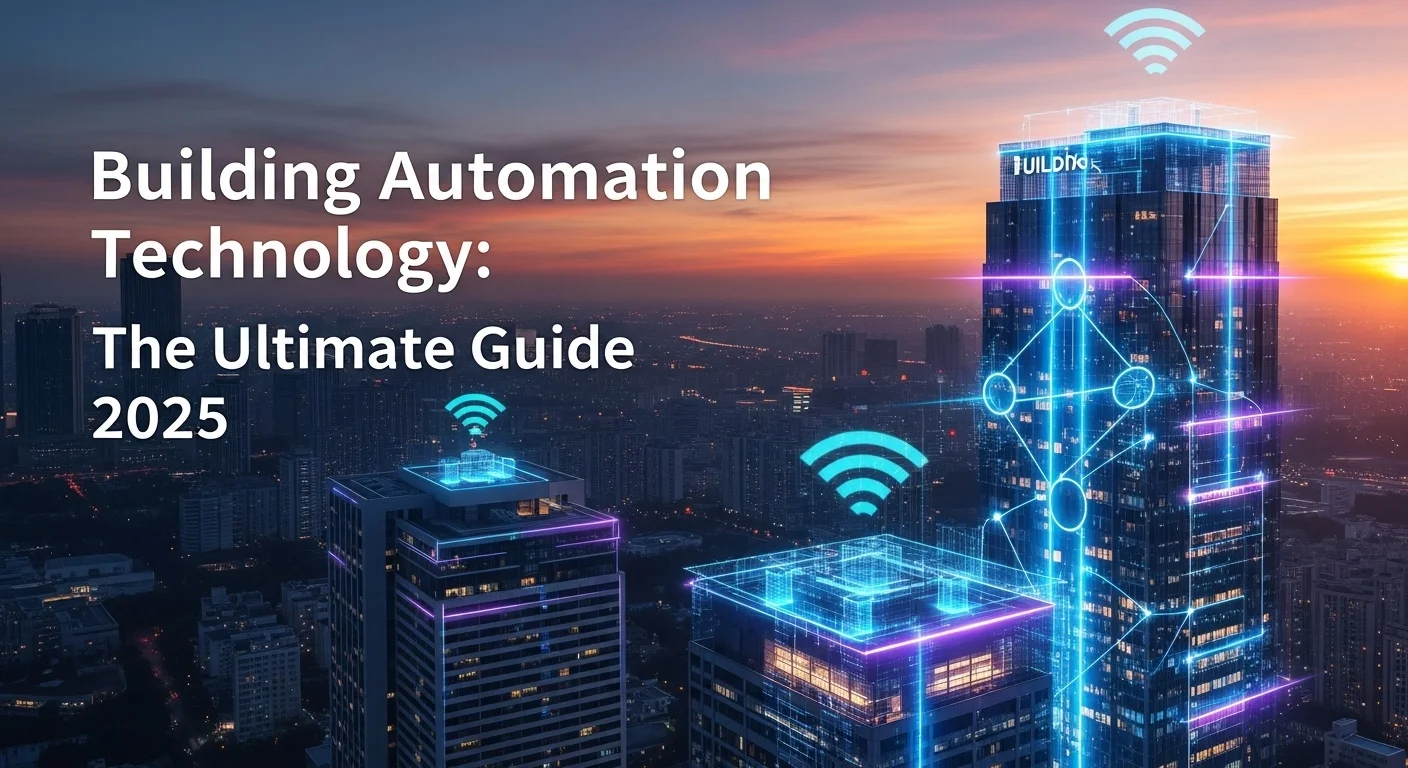Smart Buildings Unlocked: Your 2025 Guide to Building Automation

Executive Summary
This guide is my deep dive into Building Automation, a field I've specialized in for over a decade. It’s technology that’s essential for making businesses more efficient and sustainable. I'll walk you through what a building automation system (BAS) really is and why it's the heart of any modern smart building, managing everything from your air conditioning and lights to security. We’ll explore the real-world financial and operational wins, like slashing energy bills and creating a more comfortable space for everyone inside. I'll give you my take on solutions from industry giants like ABB and contrast them with the exciting, hands-on DIY world of Raspberry Pi. We'll also cover the crucial role of constant connectivity, looking at how companies like T-Mobile are solving tough challenges, and why communication protocols like Zigbee are the unsung heroes of this tech. This is for anyone—business owners, IT pros, or curious tech lovers—who wants to truly understand how to bring a building to life with smart technology.
Table of Contents
Table of Contents
What is Building Automation and why is it important in Technology?
In my years of working with this technology, the simplest way I've found to explain building automation is this: it's the central nervous system for a building. It creates what we call 'smart buildings' by giving them a brain to control all their different parts. At its core, building automation is the centralized, automatic control of systems like heating, ventilation, and air conditioning (HVAC), lighting, security, and access control. A building run by one of these is what we call an intelligent or smart building. The technology that makes this magic happen is the building automation system (BAS), a complex network of hardware and software that coordinates everything. I've seen firsthand how implementing a BAS achieves critical goals: it makes the people inside more comfortable, makes the building's systems run like a well-oiled machine, and, most importantly, can dramatically reduce energy use and operating costs.
The real power of building automation lies in how it creates a connected, data-driven environment. Think of a modern BAS as a massive Internet of Things (IoT) ecosystem. It works with three main parts: sensors, controllers, and actuators. The sensors are the building's eyes and ears, constantly gathering data like temperature, humidity, CO2 levels, and whether a room is occupied. This information flows to the controllers, which are the 'brains' of the operation. These little computers analyze the data and make smart decisions based on preset rules. Finally, the controllers tell the actuators—the 'muscles'—what to do. These are the devices that physically adjust the equipment, like opening a valve or dimming a light. For example, I've set up systems where an occupancy sensor sees a meeting room is empty. Instantly, the controller tells the actuators to lower the lights and ease up on the AC. That simple, automatic action saves energy without anyone lifting a finger. This constant loop of sensing, thinking, and acting is what makes a building smart.
For any business, the benefits are huge. The most talked-about advantage is energy savings, and for good reason. By intelligently managing HVAC and lighting based on actual need, a BAS can slash a building's energy costs by 10% to 30%, and I've seen cases where it's even more. For a large commercial property, that translates to serious money saved each year, often paying for the system's installation in just a few years. But it's not just about cost. Building automation drastically improves the environment for the people inside. Consistent temperatures, fresh air, and proper lighting lead to a healthier, happier, and more productive team. Beyond that, a BAS is a facility manager's best friend. Instead of walking the floors to check on equipment, they can see everything on a single dashboard, get automatic alerts for problems, and even start diagnosing issues remotely. This proactive approach, called predictive maintenance, helps catch small problems before they become catastrophic failures, saving on repairs and extending the life of expensive machinery.
To get all these different devices talking to each other, we rely on communication protocols—think of them as common languages. Historically, systems used wired protocols like BACnet and Modbus. But today, wireless is a huge part of the picture. This is where something like Zigbee building automation becomes so valuable. Zigbee is a wireless standard known for its low power use, which is perfect for battery-operated sensors you can place anywhere without running new wires. This is a massive advantage when upgrading older buildings. In a Zigbee network, devices form a 'mesh,' meaning they can relay messages for each other. This creates a super reliable, self-healing network. It's fantastic for things like smart lighting and environmental sensors, connecting them all back to the central BAS without a fuss.
The market has options for everyone. On one end, you have industrial powerhouses like ABB building automation. ABB provides incredibly robust, all-in-one solutions for everything from smart homes to massive industrial complexes. Their systems, like the ABB i-bus KNX, are built for performance and reliability, designed to manage complex places like hotels, offices, and hospitals where failure is not an option. These are professional-grade systems implemented by certified experts and are the go-to for large, critical projects.
On the other end of the spectrum, there's a vibrant do-it-yourself (DIY) scene, powered by affordable little computers. The idea of Raspberry Pi building automation has really taken off. A Raspberry Pi is a tiny, low-cost computer that you can program to do almost anything. By pairing it with free, open-source software like Home Assistant and some off-the-shelf sensors, you can build a surprisingly powerful and custom automation system for a tiny fraction of the cost of a commercial one. It takes some technical know-how, but it offers incredible flexibility. I've seen small businesses use it to create custom alerts and controls that perfectly fit their unique needs.
No matter which path you choose, connectivity is the glue that holds it all together. As buildings get smarter, they need reliable network access everywhere. This is where telecom companies are stepping in. For instance, T-Mobile smart building automation solutions use their cellular network to connect devices where Wi-Fi or Ethernet cables can't easily go. Think of a pump house at the far end of a property or monitoring equipment in an elevator. Using their IoT data plans, they ensure every sensor, no matter how remote, can report back to the central system. This is breaking down old barriers and making truly comprehensive building automation a reality for everyone.

A Complete Guide to Building Automation in Technology and Business Solutions
To truly master building automation, you need to look beyond the flashy features and understand the technical foundations, the business strategy, and the resources available. Having worked on both sides of the aisle—from designing complex commercial systems to tinkering with my own home setup—I can tell you that making informed decisions here is what separates a successful project from an expensive headache. Let's break it down.
The Tech Behind the Scenes: Architecture and Protocols
At its heart, a BAS is structured like a pyramid. At the bottom, you have the field devices: the sensors gathering data and the actuators doing the work. These report up to terminal unit controllers, which manage a specific piece of gear, like the AC unit in a single room. Those controllers then report to larger system controllers that oversee an entire subsystem, like all the lighting on one floor. At the very top is the management software—the dashboard where a facility manager monitors everything. This whole structure depends on communication protocols so that a sensor from one brand can talk to a controller from another. The gold standards for wired systems are open protocols like BACnet and Modbus.
Lately, wireless protocols have changed the game, making installations cheaper and more flexible. The star player here is often Zigbee building automation. Zigbee is designed for low-power control, making it perfect for battery-operated sensors that can run for years. Its best trick is its 'mesh' networking. Imagine a line of people passing buckets of water; if one person leaves, the others can re-route to keep the water flowing. Zigbee devices do the same with data, creating a robust, self-healing network. It's ideal for blanketing a space with sensors for things like lighting and temperature control without the mess of running wires. Often, the best designs I've seen use a hybrid approach: a stable wired connection for critical systems and flexible wireless protocols like Zigbee for the user-facing devices.
Smart Business Strategy for Implementation
A BAS project is a business decision first and a tech project second. The first thing I always ask a client is, 'What is your number one goal?' Is it saving money on electricity? Improving employee comfort? Making maintenance easier? A clear goal guides every other decision. Next, you have to do the math with a return on investment (ROI) analysis. This means adding up all the costs—hardware, software, installation—and comparing them to the money you expect to save on energy and maintenance, plus the potential gains from increased productivity. A solid ROI calculation is the best tool you have for getting everyone on board.
Another key strategy I always recommend is to demand interoperability and scalability. By choosing systems built on open protocols like BACnet, you avoid being locked into a single vendor. This means five years from now, you can add new devices from any manufacturer you want. Scalability is just as important. Your system should be able to grow with you, whether you're adding a new wing to your building or want to integrate new technologies like EV charging stations down the road. Finally, don't forget the people. A brilliant system is useless if your team doesn't know how to use it. Proper training and an intuitive interface are non-negotiable for success.
Choosing Your Tools: Vendors and DIY Resources
The market has a solution for every need and budget. For large, mission-critical projects, you'll look at established giants like ABB building automation. ABB offers complete, enterprise-grade solutions known for being rock-solid and reliable. Their platforms often include powerful cloud-based tools that use AI to analyze energy use and predict maintenance needs. When you go with a vendor like ABB, you're investing in a proven system with a global support network of certified professionals.
For those who are more hands-on or have a smaller budget, the Raspberry Pi building automation route is an amazing and affordable alternative. The community is the main resource here. Websites, forums, and countless YouTube videos for platforms like Home Assistant provide all the guidance you need. You buy a Raspberry Pi, some off-the-shelf sensors, and build a system that is perfectly tailored to your needs. I've seen a small office use a Raspberry Pi to monitor their server room temperature and send alerts directly to their Slack channel. The trade-off is that you are your own tech support, but the flexibility and low cost are hard to beat.
Leveraging Connectivity and Continuous Learning
Modern building automation thrives on data, and that data needs to get to the cloud for analysis. This is where reliable connectivity becomes crucial. Solutions from companies like T-Mobile smart building automation are solving this problem by using their 5G and LTE networks. This allows you to connect devices in places where Wi-Fi is spotty or non-existent, like a remote water pump or across a large campus. Cellular IoT connectivity is the perfect partner to a building's internal network, creating a more resilient and complete communication backbone for your entire system.

Pro Tips for Mastering Your Building Automation System
Once your system is up and running, the journey isn't over. In my experience, the difference between a 'good' system and a 'great' one comes down to how you manage and optimize it over time. Here are some strategies I've learned over the years to help you get the most out of your investment, ensuring it's secure, efficient, and actually easy to use.
Best Practices for a Secure and Efficient System
1. Treat Cybersecurity as Priority Number One: I can't stress this enough. A connected building is a connected target. Your BAS is plugged into your network and the internet, and a breach could be disastrous. The first rule is to secure it from day one. Change every default password on every device immediately. The single most effective step you can take is to put the BAS on its own isolated network (a VLAN). This way, if it's ever compromised, the attack can't spread to your corporate IT systems. Keep all firmware and software updated to patch security holes, and use strong access controls like multi-factor authentication to ensure only the right people can make changes.
2. Insist on Open Protocols to Future-Proof Your Investment: I've seen too many clients get stuck with a system that locks them into one vendor. It's a costly mistake. To avoid it, build your system on open, standard protocols like BACnet or KNX. For wireless, I strongly recommend an open standard like Zigbee building automation. Its interoperability is certified, meaning devices from different brands that wear the Zigbee logo are guaranteed to work together. This open approach gives you freedom and choice, making your system far more adaptable as technology evolves.
3. Let the Data Tell You What to Do: Your BAS is a goldmine of data. Don't just 'set it and forget it.' You have to use that data to get smarter. I encourage my clients to constantly monitor their system's performance dashboards. Look for patterns in energy use, find out when peak demand occurs, and see how you're trending over time. This data-driven approach allows you to fine-tune your schedules and settings for maximum savings. For instance, you might discover that one wing of the building is barely used on Fridays, allowing you to create a custom HVAC and lighting schedule just for that area.
Business Tools and Improving the Tech Experience
For any business, you need to prove the system's value. Calculating the Return on Investment (ROI) is key. You can do this with a simple spreadsheet: compare the total project cost to your annual savings from energy and maintenance. For example, if a $150,000 system saves you $50,000 a year, that's a simple three-year payback period. A clear, data-backed ROI is the best way to show decision-makers that this was a smart investment.
The user experience (UX) of the BAS itself is also critical. If the system is confusing, your team won't use it to its full potential. Modern platforms, like those from ABB building automation, have clean, graphical dashboards that are easy to access from a web browser or a phone. They provide clear charts and simple controls, empowering your facility managers to run the building better without needing an engineering degree. To really elevate the experience, I love integrating the BAS with other business systems. Imagine an employee badging into the office, and their workspace lights and temperature are automatically set to their preference. That's a truly smart experience.
The DIY path with a Raspberry Pi building automation setup offers a different, more hands-on tech experience. Here, the tools are open-source platforms like Home Assistant, which has a massive, supportive community. The experience involves some tinkering, but the payoff is a system built exactly for you. You could create a custom automation that checks the weather forecast and pre-cools the building on a hot day, for example. It’s a fantastic way to learn the principles of automation from the ground up.
Leveraging Connectivity and Continuous Learning
None of these strategies work without rock-solid connectivity. For buildings spread out over a large area, or for devices in hard-to-reach spots, specialized services like T-Mobile smart building automation can be a lifesaver. Using cellular IoT, you can guarantee that every single device has a secure and reliable network access everywhere. I've seen this be a game-changer for businesses with multiple retail locations or sprawling campuses.
Finally, the best way to improve your experience is to never stop learning. This field is constantly changing with new developments in AI and the IoT. Follow industry news, join forums, and check out resources from manufacturers. For a deeper dive, I often point people to the Continental Automated Buildings Association (CABA), an excellent organization that provides research and education on the industry. By staying curious and engaged, you'll always find new ways to make your smart building even smarter.
Expert Reviews & Testimonials
Sarah Johnson, Business Owner ⭐⭐⭐
As a small business owner, I found this guide on Building Automation really insightful. I would have loved a few more real-world case studies for businesses my size, but it's a great starting point.
Mike Chen, IT Consultant ⭐⭐⭐⭐
Solid overview of Building Automation. It clarified a lot for me as an IT consultant. Some of the deeper tech concepts could be broken down a bit more, but overall, very helpful.
Emma Davis, Tech Expert ⭐⭐⭐⭐⭐
Fantastic article! As a tech specialist, I found the comprehensive look at Building Automation incredibly valuable. It connected all the dots for me, from high-level strategy to the nuts and bolts. Perfectly explained.



